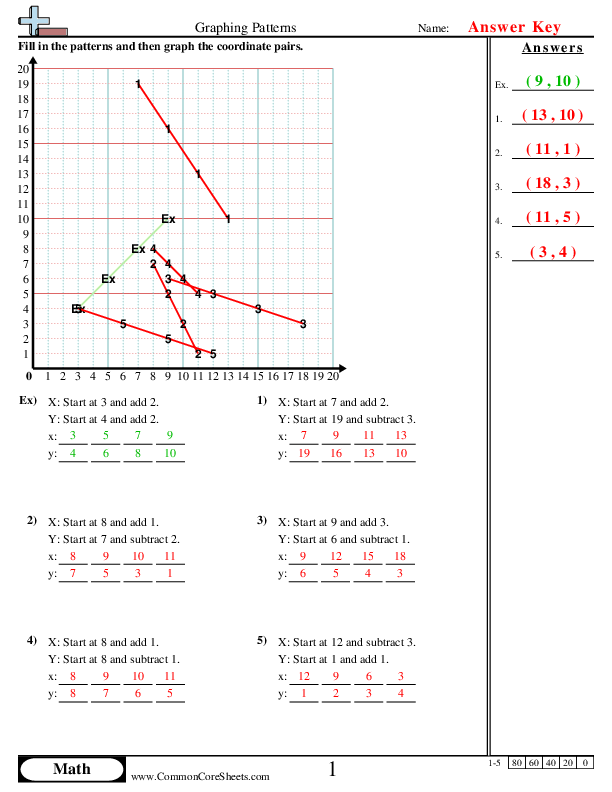Our graphing worksheets are the best on the internet for helping students learn how to graph data and interpret the results. These free worksheets cover a wide range of topics, including graphing positive and negative coordinates, reading a coordinate plane and many more. Our worksheets are designed to be easy to use and understand, making them perfect for students of all ages. Whether you're a teacher looking for the best graphing worksheets to use in your classroom, or a student looking to improve your graphing skills, these worksheets are the perfect resource. So why wait? Start using our graphing worksheets today and see the difference they can make in your understanding of this important topic!
Browse Sheets By Problem Type
×
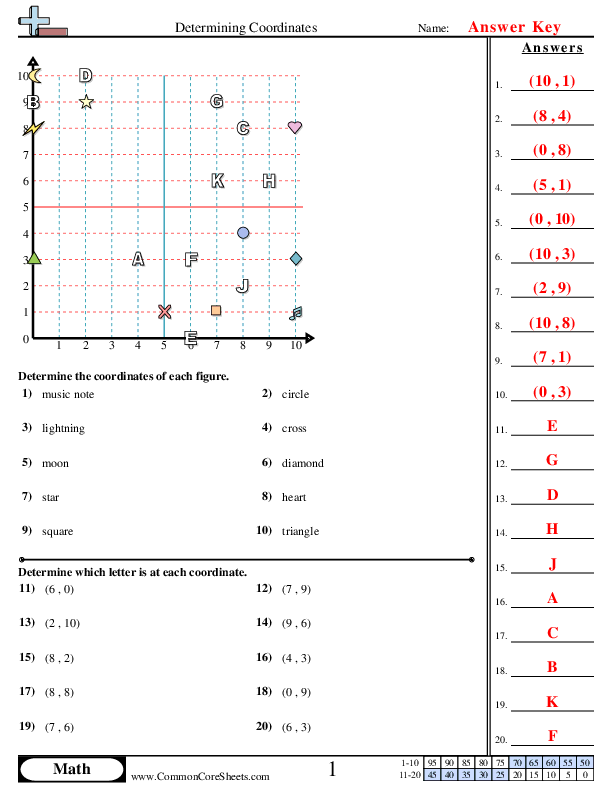
All positive coordinates
5g2


×
Description:
"This worksheet is designed to fortify children's understanding of coordinates in math through a variety of shapes and symbols. Comprising 20 problems, ranging from squares and stars to unique shapes like a music note and lightning, it enhances problem-solving skills. Ideal for distance learning, this worksheet can be customized based on unique learning needs and even converted into flashcards for dynamic study sessions."

×
Student Goals:
Enhance Analytical SkillsBy successfully completing the coordinates worksheet, students get the opportunity to enhance their analytical skills. Analyzing and interpreting the patterns of coordinates can be a challenging task, but doing so can significantly improve a child's ability to think critically and logically.Develop Problem-Solving SkillsWorking on the problems in this worksheet will promote problem-solving skills among students. Each problem is different, requiring them to think in varying ways to find the solutions. Such exercises contribute to their capability to handle more complex problems in the future.Improve Geometry KnowledgeThis worksheet allows students to explore different geometric shapes and structures. In the process, they will gain a better conceptual understanding of basic geometry. They will be able to recognize and differentiate between various shapes such as circles, triangles, squares, etc., which are fundamental in the study of geometry.Strengthen Mathematical VocabularyStudents will undoubtedly strengthen their mathematical vocabulary upon completion of this worksheet. The exercise introduces and reinforces geometry-related terms and concepts. This improved familiarity with the language of mathematics better prepares them for future mathematical studies.Boost ConfidenceSuccessfully determining coordinates and navigating the problems in the worksheet helps build confidence in a child's mathematical capabilities. With every problem they solve, their self-assurance will grow, instilling in them the belief that they can tackle complex mathematical problems or any challenges they might face in their academic journey.Promote Attention to DetailThe worksheet encourages precision and attention to detail. Students will need to pay careful attention to each coordinate and shape to arrive at the correct answer. This focus on precision will help them excel not just in mathematics, but in all areas requiring attention to detail.Develop Coordinate Plane UnderstandingLastly, completing the worksheet should equip students with a solid foundation in understanding the coordinate plane. This is a valuable skill in mathematics, which will be useful in later studies, especially in subjects like calculus, physics, and more advanced geometry.


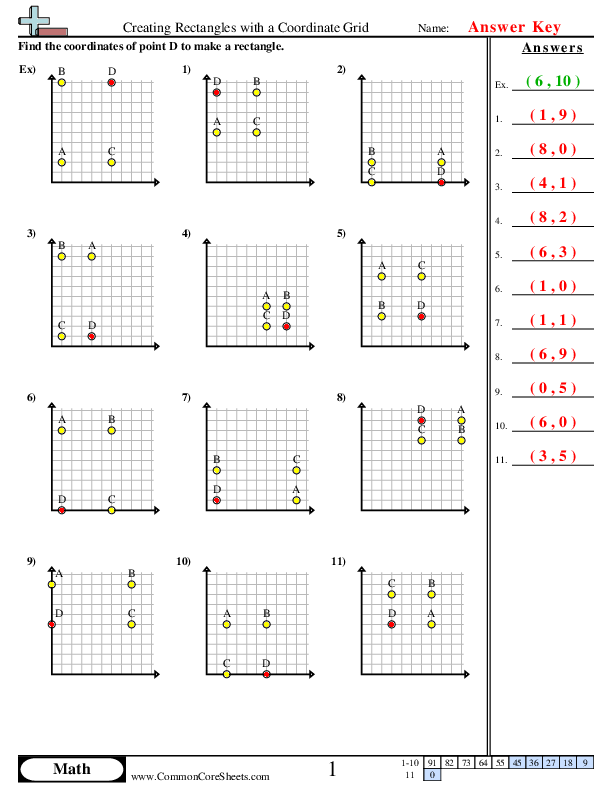
Creating Rectangles with a Coordinate Grid
5g1


×
Description:
"This worksheet is designed to help children master the concept of creating rectangles using coordinate grids. With 11 practice problems, it offers hands-on math learning in a clear, interactive way. The worksheet can be customized according to individual student needs, transformed into flash cards for quick revision or incorporated into distance learning programs. It's a versatile and practical tool for educators and students alike."

×
Student Goals:
Understanding Coordinate Grid ConceptsUpon completion of the 'Creating Rectangles with a Coordinate Grid' worksheet, students should have developed an appreciation and understanding of coordinate grid concepts in maths, specifically regarding rectangle plotting and formation. They will possess the knowledge and confidence to plot vertices of rectangles using an X-Y coordinate grid. With this competency, students will be able to create rectangles on given coordinates and understand how the position of specific points on the coordinate grid creates different forms of rectangles.Improvement in Problem Solving SkillsEnhancement in problem-solving skills will be a significant accomplishment after the completion of the worksheet. The worksheet, having eleven problems, provides students with various scenarios where they leverage critical thinking and reasoning abilities to create rectangles using the coordinate grid. With the practice of different problem sets, students will gain the ability to solve complex rectangle plotting issues and decode problems related to the geometric aspect of mathematics.Enhancement in Geometrical SkillsGeometrical skills are at the heart of this exercise. By correctly forming rectangles on a coordinate grid, students demonstrate their ability to recognize shapes and their properties, improving their geometric aptitude. As young learners navigate this exercise, they also implicitly bolster their understanding of the importance of angle calculation, symmetry, spatial reasoning in rectangles, and knowledge that will be beneficial in further geometrical studies.Development of Analytical SkillsAnalytical skills are another key area of development for students completing this worksheet. Decoding the position of vertices helps in enhancing deductive reasoning skills and honing attention to detail. This analytical awareness will also enable students to draw conclusions about rectangular shapes and develop hypotheses about other geometric shapes.Boost in ConfidenceFinally, a boost in confidence is inevitable after successfully completing the worksheet. Conquering new concepts, applying them through problems, and perfecting their understanding ultimately leads to a sense of achievement and boost in belief level. Therefore, the worksheet plays a significant role in boosting the confidence that they will carry into other areas of their academic study and beyond.



Reading a Coordinate Plane
5g1


×
Description:
"This worksheet is designed to bolster children's understanding of coordinate planes in mathematics. It houses 15 problems that challenge students to identify shapes positioned at given coordinates. Besides reinforcing key math concepts, the worksheet offers flexibility; it can be customized to meet individual learning needs, transformed into flashcards for easier assimilation, or adapted for distance learning environments. A perfect tool for comprehensive and engaging math education."

×
Student Goals:
Identification of Coordinate PlanesUpon completion of this worksheet, students should be able to effectively identify coordinate planes. They will be familiar with the correlation between a set of coordinates and its corresponding location on the coordinate plane, enhancing their ability to translate numerical information into a visual representation. This knowledge is fundamental to many areas of mathematics, especially geometric and algebraic understanding.Analytical SkillsStudents will have honed their analytical skills, given that interpreting coordinate planes requires an understanding of the relationship between two dimensions. Working through the 15 problems in this worksheet will foster strategic thinking and problem-solving abilities, underpinning their confidence to tackle more complex mathematical problems in future.Mastering Mathematical ConceptsCompletion of this worksheet will indicate mastery of the concept of coordinate planes, an integral part of the geometry curriculum. The proficiency gained in visualizing mathematical relationships and functional interactions is crucial not just in math, but also in numerous areas in the sciences, such as physics and computer science.Fundamental Metric InterpretationStudents will be practiced in interpreting fundamental metric coordinates, an important skill that finds application in real-world scenarios. These can range from reading maps in geography to interpreting data points on graphs in business, economics or scientific research. This trans-disciplinary skill will render their mathematical abilities more tangible and applicable to diverse fields.Independent Study and ConfidenceBy completing these problems independently, students will build confidence in their mathematical abilities. They'll be encouraged in their self-directed learning, which will promote resilience in future academic pursuits. The mastery and confidence students gain through this worksheet will leave them well-placed to tackle more complex maths topics with assurance and aplomb.



Marking Locations on a Grid
5g1


×
Description:
"This worksheet is designed to hone math skills by teaching children spatial awareness through marking locations on a grid. It features 12 problems, invaluable for developing students' understanding of coordinate systems. It's adaptable - it can be customized to challenge different ability levels or turned into flashcards for interactive study. An ideal tool for distance learning, it facilitates independent practice in a focused, engaging way."

×
Student Goals:
Build Spatial Recognition SkillsStudents who complete this worksheet should develop superior spatial recognition abilities. Spatial recognition is a vital part of mathematical understanding, especially in the field of geometry. This worksheet enables students to understand the layout of a grid, a foundational component of many mathematical concepts. It aids students in recognizing the horizontal and vertical axes on a grid and how they combine to form coordinates. This is a critical step in enhancing their spatial vision and their capacity to understand and describe the space around them.Enhance Problem-Solving SkillsThis worksheet will also play a crucial role in strengthening students' problem-solving skills. They're tasked with identifying and marking multiple specific locations on a grid, which promotes their ability to address issues individually and successfully. This interactive task encourages self-reliance and confidence in their problem-solving capabilities, which are essential skills in quantitative subjects like mathematics, but also have useful applications in day-to-day life.Comprehend and Use Mathematical LanguageBy marking locations on the grid, students should achieve a more thorough comprehension of mathematical language, particularly the terminology and principles related to coordinates and grids. Understanding this jargon is essential to communicating mathematical ideas and methods, as well as interpreting problems. The completion of this worksheet is a step towards fluency in mathematical language, which will be invaluable in more advanced study.Reinforce Coordinate System KnowledgeThe worksheet specifically focuses on the coordinate system, a fundamental aspect of mathematics. Therefore, students who complete this worksheet should learn or reinforce their capacity to read, understand, and utilize this system. Using a pair of numbers to represent a point in space is an abstract concept, and by physically marking these points on a grid, the idea becomes more concrete for students. This supports learning, retention, and future use of the coordinate system.Promote Accuracy and Attention to DetailLastly, this worksheet should enhance students' accuracy and attention to detail. It's essential to place the points precisely in the right spot to get the correct answer. Thus, the task encourages a thorough and careful approach to work, traits that are not only important in mathematics but also highly valued in many aspects of life


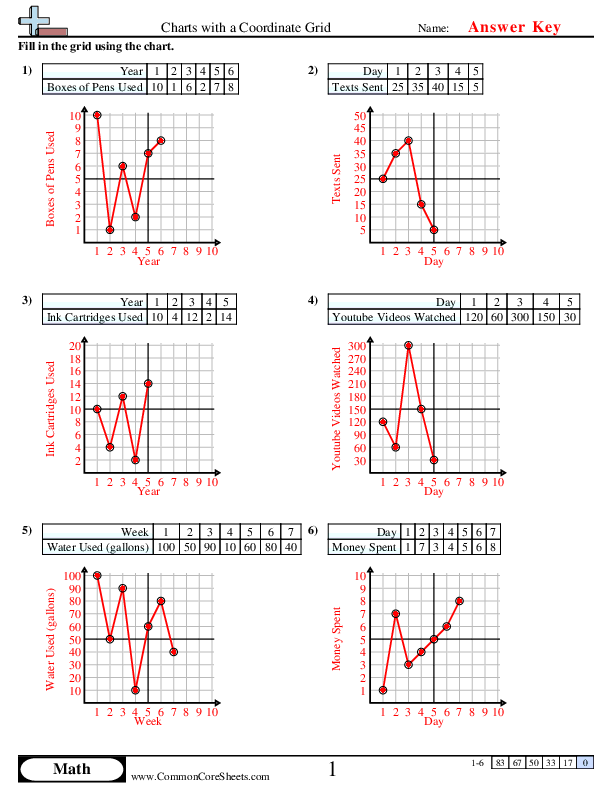
Charts with a Coordinate Grid
5g2


×
Description:
"This worksheet is designed to enhance children's understanding of math through engaging problems related to coordinate grid charts. Six distinct problems tackle concepts such as days and meals sold, weekly TV watched hours, sales hourly rates, weekly water usage, daily YouTube video consumption, and yearly pen use. It's customizable to meet individual learning needs, perfect for converting into flashcards, and fits seamlessly into distance learning methodologies."

×
Student Goals:
Develop Mathematical SkillsAfter completing the worksheet, students will be able to enhance their mathematical skills. This process will help them understand numerical concepts better and apply them in different contexts. They will be capable of working with numbers in a more analytical way. The experience will add to their cognitive abilities, letting them realize patterns, relationships, and logic in a mathematical framework.Understand Coordinate GridThe worksheet will help students comprehend the concept of a coordinate grid. They will understand how to plot numbers on a grid, recognize the importance of coordinates and their location. This will allow them to interpret data in a more visual form. The ability to present data on charts will enable simplified complexity in the information to be understood more easily.Improve Problem SolvingThis assignment will sharpen the students' problem-solving abilities. They will learn how to approach mathematical problems methodically, which will enhance their decision-making process. By solving different types of problems, students will gain a range of strategies that can be adopted to crack mathematical puzzles.Interpret Data and GraphsAfter going through the exercises, students will develop an improved ability to interpret data and graphs. They will learn how to read, understand and analyze the data presented in various graph forms. They will be able to decipher the purpose of display graphics, interpret the significant data points, and draw accurate conclusions from the visual representations of numerical data.Enhance Logical ReasoningFinishing this worksheet will contribute to honing students' logical reasoning. By manipulating numbers and analyzing patterns, they will be able to develop coherent arguments and improve their capacity to think logically. This skill will help students beyond mathematics, assisting them in all subjects that require logic and reasoning.Application of Practical Life ConceptsFinally, the tasks will let students apply mathematical concepts to everyday life. The charts and grids present data on common subjects like calories burned, water used, and so on. This encourages students to think of math as not just an abstract field of study but as a practical tool that can be used to understand and navigate the world around them.


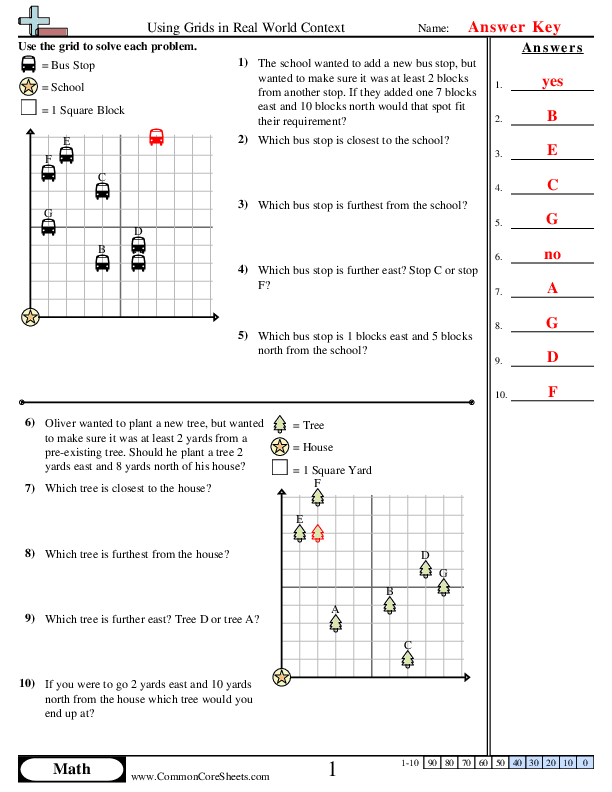
Using Grids in Real World Context
5g2


×
Description:
"This worksheet is designed to enhance children's practical understanding of grids through real-world scenarios, using a set of 10 math problems. It focuses on spatial concepts, such as distance and coordinates. The problems presented can be easily customized, converted into flashcards, or adapted for distance learning, offering versatile solutions to make grid learning engaging and effective."

×
Student Goals:
Understanding the Concept of GridsStudents will develop a basic understanding of the concept of grids after completing this worksheet. They should be able to recognize grids as a tool for locating points within a given area, as well as be familiar with the terms 'east', 'west', 'north', 'south' as they relate to grid navigation.Application of Mathematical ConceptsStudents will be able to successfully apply mathematical concepts by interpreting and solving problems that involve distances and location. They should be able to differentiate between distances closer and further from a certain point. This worksheet makes them adept at handling practical mathematical problems common in real-life scenarios, such as determining the placement of a bus stop or a well using a set of given rules.Developing Analytical and Planning SkillsBy completing this worksheet, students will learn to use analytical and planning skills to solve problems. They will understand how decisions are made attending to specific criteria and they will be able to make inferences, analyses, and predictions based on the information available on the grid.Improving Critical Thinking SkillsThe worksheet fosters the enhancement of critical thinking skills. Students should be able to process the provided information, make informed decisions, and offer possible solutions to problems. These skills are essential in today's rapidly changing world, not only in academics but also in everyday life challenged with complex scenarios.Boosting Sarial ReasoningThis worksheet will enhance the students' spatial reasoning abilities. They will become more adept at using grids to locate directions and comprehend the relative positions of different points, understanding the relationships between different objects and spaces.Better Problem-Solving AbilitiesThe worksheet enables the students to strengthen their problem-solving skills. They will learn to identify the problem, decipher the underlying requirements, apply appropriate methods, and arrive at solutions. They will become more proficient at solving various types of problems involving distances and locations on a grid.


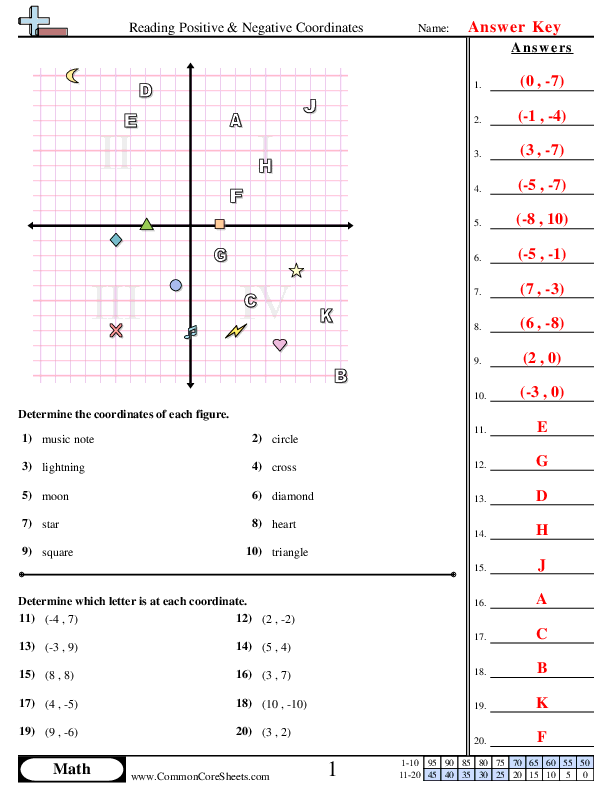
Positive and Negative
6ns6c


×
Description:
"This worksheet is designed to teach children the concept of positive and negative coordinates in a fun, interactive way. Using geometric shapes and familiar objects like a star, heart, or moon, this customizable worksheet presents 20 problems ideal for learning via flashcards or distance education. With practice, students will master the math skill of reading coordinates effectively."

×
Student Goals:
Understanding of Coordinate SystemUpon the successful completion of this worksheet, the students will have a deeper understanding of the positive and negative coordinate system, a crucial concept in mathematics. They will learn the basics of graphing, addressing both the x and y coordinates, and how to plot points correctly using positive and negative numbers.Improved Problem Solving SkillsWork through the entire set of problems will help the students to strengthen their problem-solving skills. The 20 problems on the worksheet have been designed in such a way that they test the students' ability to interpret and work out solutions convincingly. Each problem presents a unique challenge, further motivating students to think critically and logically.Competency in Navigating 2D SpaceThe students will demonstrate a proficiency in navigating the two-dimensional space effectively. This skill will come in handy when carrying out analytical tasks in later grades, especially in subjects that require the use of diagrams and charts such as Geometry and Physics.Application of Knowledge to Real World ScenariosThe students will be able to apply the knowledge gained from the worksheet, not just in the academic context, but also in real-life scenarios. The understanding of coordinates is beneficial in a diverse range of fields, including Computer Science, Geography, Engineering, Architecture and more. This is, therefore, a significant step in equipping them with relevant skills for the future.Enhanced Math VocabularyStudents will further solidify their math vocabulary relevant to coordinate systems, including terms like 'axis', 'origin', 'quadrant', 'coordinates', 'positive', and 'negative'. Confident use of the appropriate mathematical language helps students to communicate their understanding effectively.Confidence and Independence in LearningCompleting the worksheet will also foster a notable level of confidence and independence in the students. Attempting, solving, and correcting errors all by themselves will encourage them to take charge of their learning process and not shy away from attempting challenging problems in future.



Examining Graphs
7rp2d


×
Description:
"This worksheet is designed to improve children's competencies in math, specifically in the area of interpreting and examining graphs. It contains three engaging problem sets featuring realistic scenarios like printing pages, earning points by defeating enemies, and counting candies. These concepts are tailored to keep children interested while developing their graph reading skills. The worksheet can be customized and converted into flash cards to aid in review, and it is suitable for distance learning."

×
Student Goals:
Understanding GraphsAfter completing the worksheet, students should be able to thoroughly understand and interpret various types of graphs. They will gain in-depth knowledge of how data is represented graphically and how it translates into real-life situations. Decoding the relationship between various data points on the graph should come easily to them.Develop Mathematical SkillsThe worksheet will play a crucial role in improving students' mathematical skills. Successfully navigating through the problems will help them apply basic arithmetic operations and understand correlations. This will also aid in the development of their problem-solving approach, numerical fluency, and critical thinking.Relating Mathematics to Real-World ScenarioThe completion of the worksheet allows students to develop a vital skill - connecting mathematical concepts to everyday life situations. They will have a clearer understanding of how mathematical graphs are used to represent and decode information in various fields, enhancing their practical knowledge.Analytical SkillsStudents will foster their analytical skills as they dissect the elaborate data sets represented in the graphs. Analyzing different sets of data will allow them to draw conclusions and comparisons, boosting their analytical abilities.Attention to DetailBy working through the problems on this worksheet, students will enhance their attention to detail. They will have to closely examine the different data points and their corresponding values to solve the problems, thereby promoting precision and meticulousness in their work.Understanding of Quantitative RelationshipsThe worksheet will help students recognize and comprehend the quantitative relationship between different elements. They will be able to predict and interpret how a change in one quantity can affect another, thereby augmenting their understanding of dependent and independent variables.


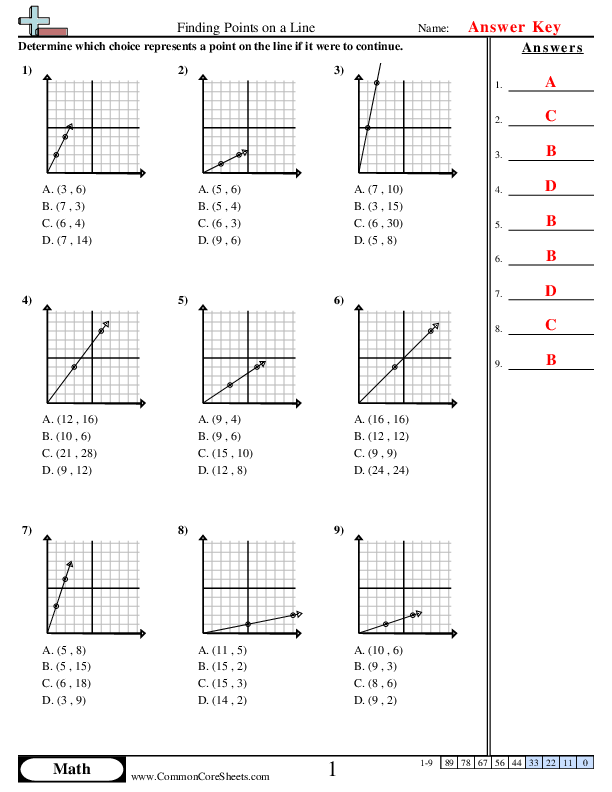
Finding Points on a Line


×
Description:
"This worksheet is designed to bolster children's mathematical skills, specifically in understanding and finding points on a line. With a set of 9 engaging problems, learners can identify patterns and relationships in different coordinates. Versatile and customizable, it can be transformed into flash cards, aiding hands-on learning, or seamlessly integrated into distance learning curriculums, thus offering flexibility in instructional delivery and enhancing children's spatial awareness in the realm of mathematics."

×
Student Goals:
Develop Mathematical UnderstandingAfter completing the worksheet, students should have enriched their mathematical comprehension, particularly concerning the concept of plotting points on a line. They will grasp the fundamentals of coordinate geometry and how it represents a system for specifying positions on a plane. This understanding will help them to excel not only in various math problems, but also in different areas of scholastic pursuit that require data visualization and spatial reasoning.Enhance Problem-Solving SkillsWorking through the problems in the worksheet, students ought to hone problem-solving skills by learning how to approach a question logically and systematically. This experience will heighten their analytical thinking skills and promote reliance on strategic planning. It will also foster resilience in the face of complex tasks, thereby encouraging them to persevere until they find solutions.Sharpen Precision and AccuracyThe completion of these exercises is an opportunity for students to develop a keen eye for precision and accuracy. Dealing with coordinates demands a meticulous approach and focuses on specific details. This trait is vital in various scientific and mathematical domains where leaving out a minute detail can significantly alter results.Gain Applied KnowledgeAfter concluding the worksheet, learners will be equipped not only with theoretical knowledge, but also with the ability to apply such knowledge in real-world scenarios. Understanding points on a line and their representations expands one's capacity in tackling graph-related contexts. This interactive, applied form of learning can connect abstract ideas to concrete experiences.Bolster Confidence in MathAs students find correct solutions to the problems provided, they should feel increased confidence in their math abilities and aptitude. This self-assurance can motivate them to take on more challenging mathematical problems and larger complexities. Moreover, it can diminish math-related anxiety and promote a positive attitude towards future mathematical endeavors.Promote Independent LearningBy providing solutions independently for this worksheet, students will have advanced their self-guided learning abilities. Such abilities play a crucial role in nurturing intellectual autonomy and instilling a lifelong love for learning. Furthermore, this fosters accountability and responsibility for their educational advancement.




